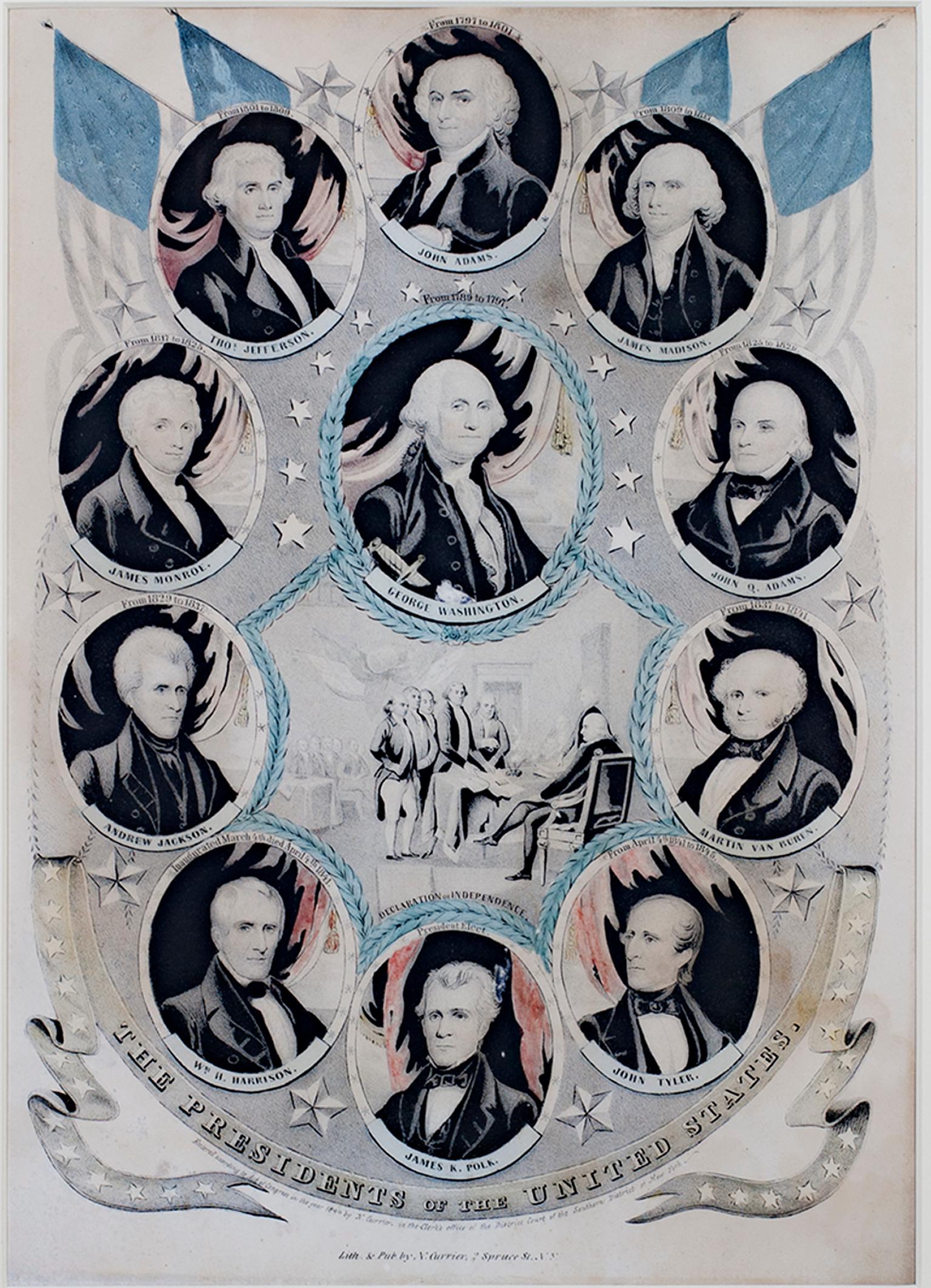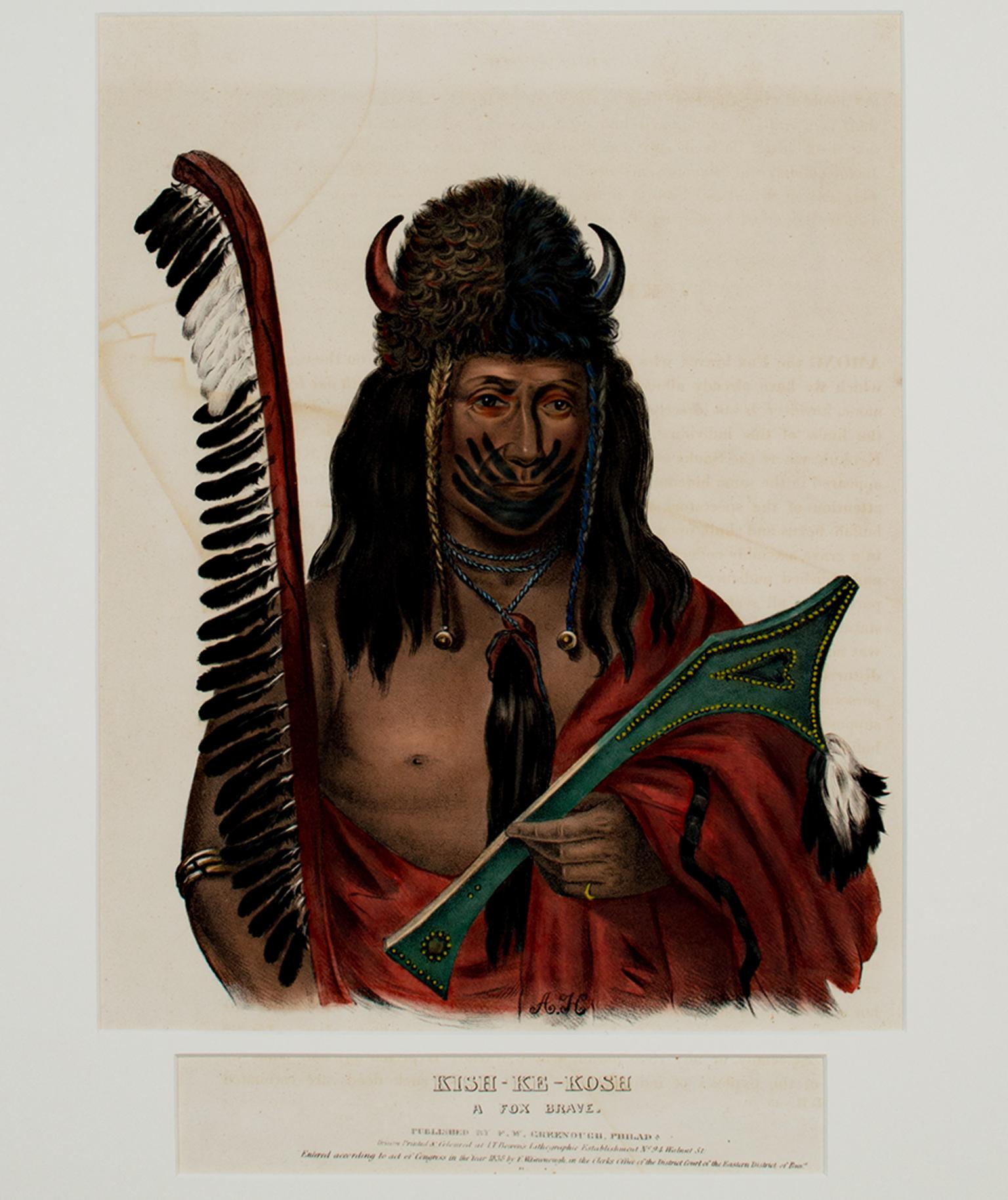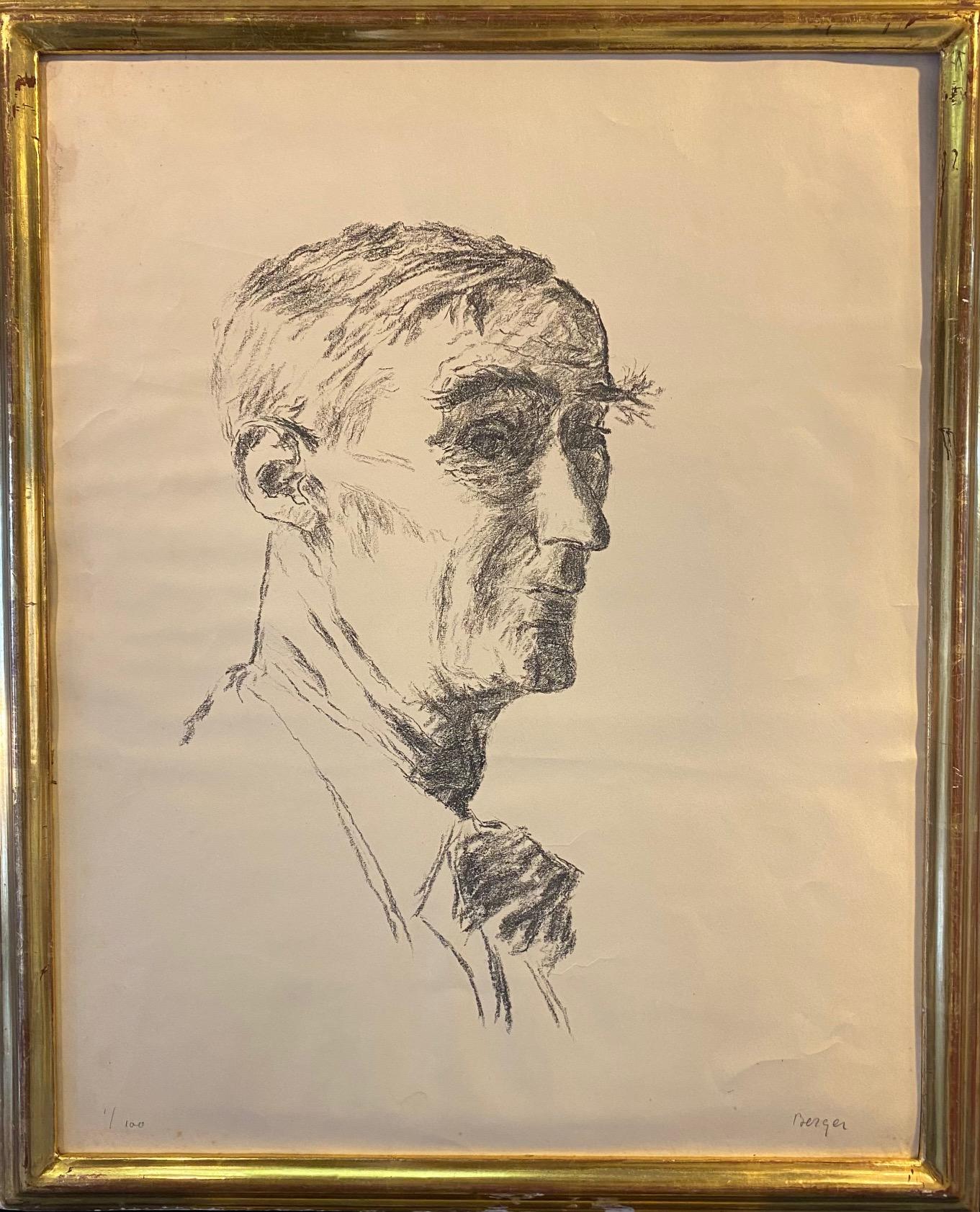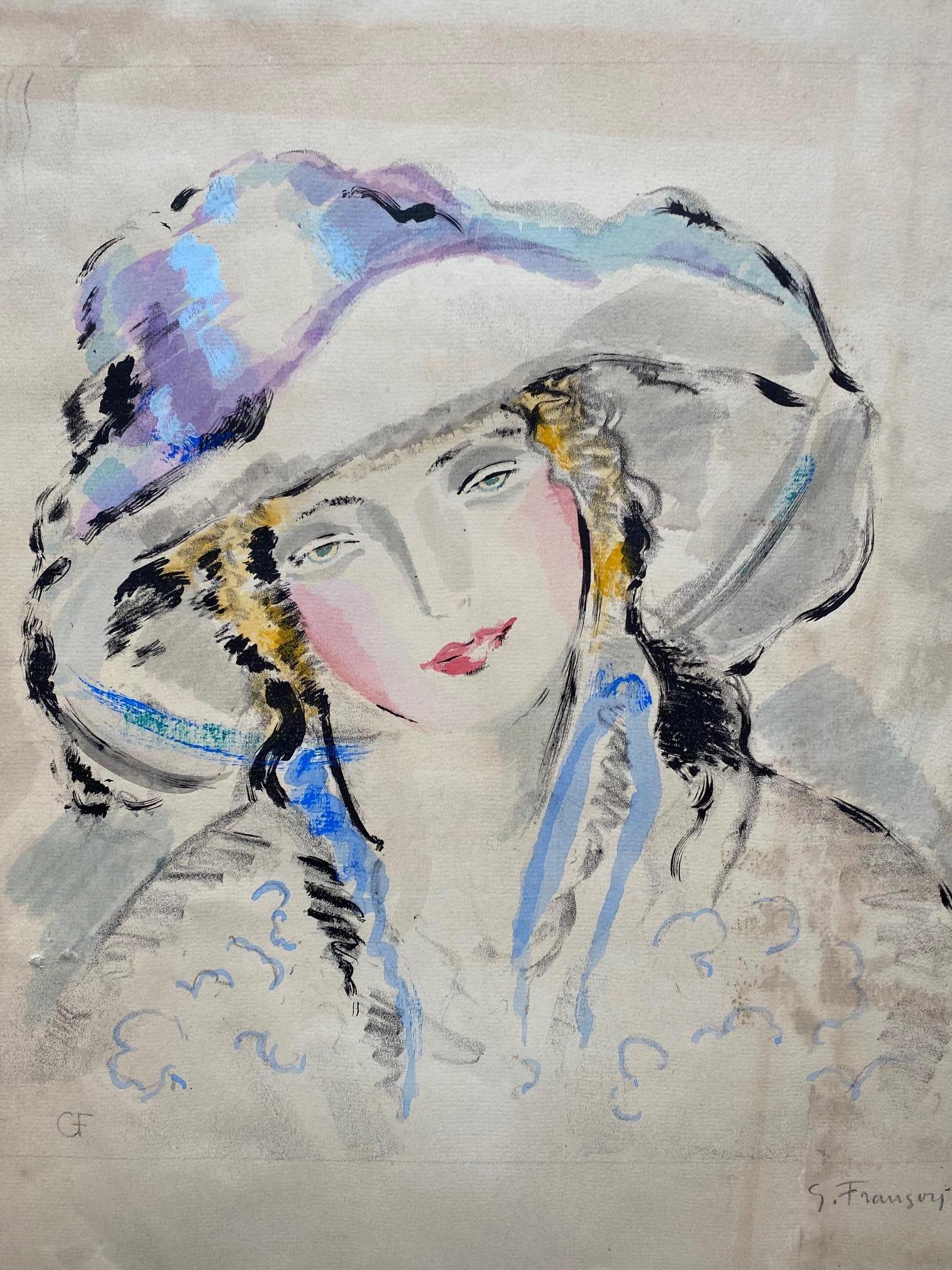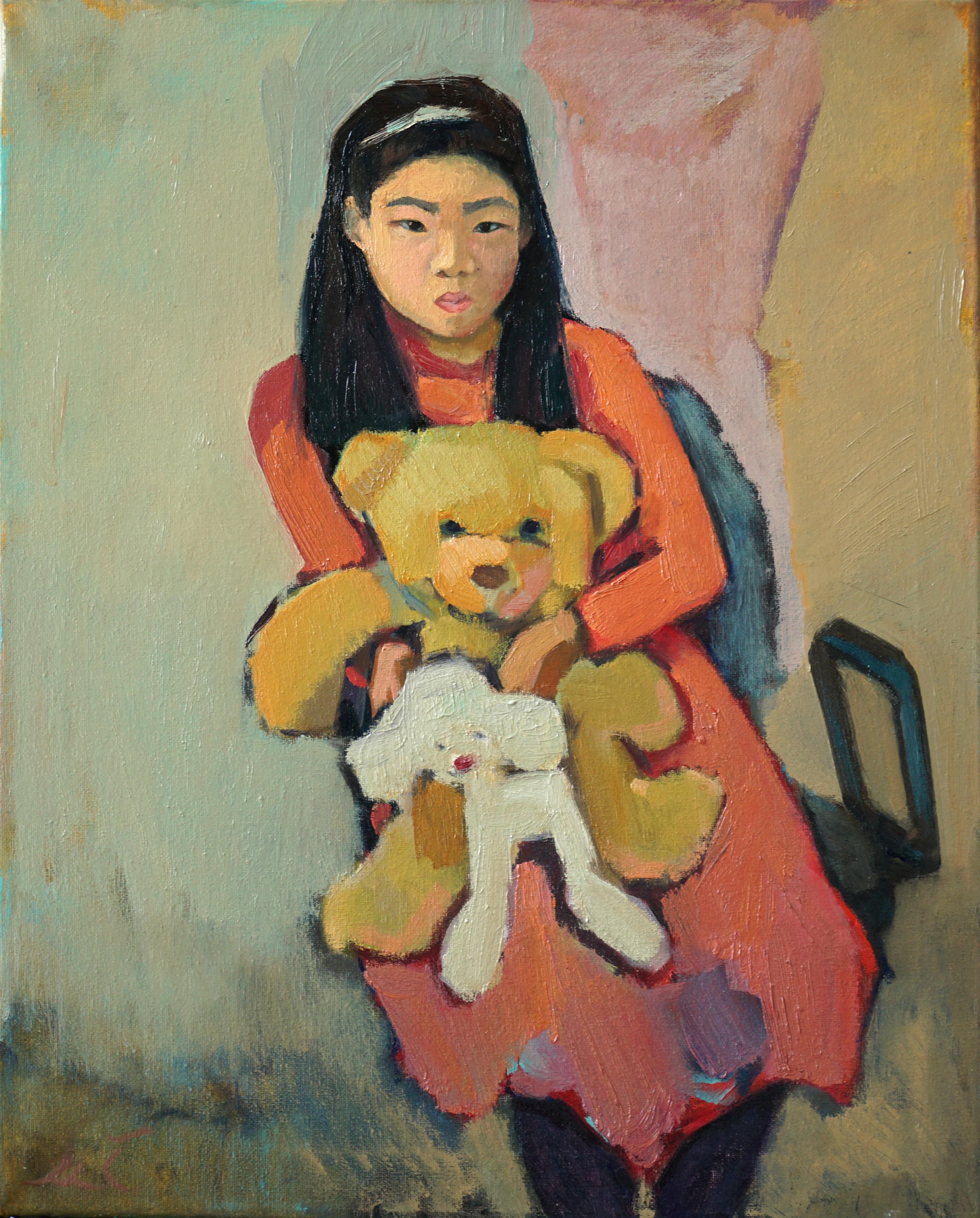Items Similar to 19th century color lithograph portrait indigenous male subject feathers signed
Want more images or videos?
Request additional images or videos from the seller
1 of 8
McKenney & Hall19th century color lithograph portrait indigenous male subject feathers signed1838
1838
About the Item
"Wa-Em-Boesh-Kaa, A Chippeway Chief," is an original hand-colored lithograph by McKenney & Hall. It features a portrait of a notable Native American chief, with informational text below.
13 1/2" x 18 3/4" paper
25 5/8" x 20 1/2" frame
American lithograph publishers. Most well-known for "History of the Indian Tribes of North America," a collection of 125 images that included biographical sketches and anecdotes of principal chiefs. Thomas Loraine McKenney (1785-1859) served as Commissioner of Indian Affairs from 1824 to 1830. In that capacity he commissioned and collected portraits of Native Americans for his Gallery in the War Department. McKenney's goal was to publish a record of vanishing peoples: portraits, biographical sketches and a history of North American Indians. He accomplished this in the first issue of the History of the Indian Tribes of North America, published in three volumes between 1838 and 1844. James Hall (1793-1868) provided the text.
- Creator:
- Creation Year:1838
- Dimensions:Height: 25.625 in (65.09 cm)Width: 20.5 in (52.07 cm)
- Medium:
- Movement & Style:
- Period:
- Condition:
- Gallery Location:Milwaukee, WI
- Reference Number:
McKenney & Hall
Col. Thomas J. McKenney was Superintendant of The Bureau of Indian Affairs from 1816 until 1830. He was one of a very few government officials to defend American Indian interests and attempt to preserve their culture. He travelled to Indian lands meeting the Native American leaders. He brought with him an accomplished artist, James Otto Lewis, who sketched those willing to participate. A large number of the most influential Indian chiefs and warriors were later invited to come to Washington in 1821 to meet President Monroe. McKenney commissioned the prominent portrait painter Charles Bird King, who had a studio in the capital, to paint these native American leaders, who chose the costumes they wished to wear for the sitting. The magnificent resultant paintings were displayed in the War Department until 1858, and were then moved to the Smithsonian Institute. When Andrew Jackson dismissed McKenney in 1830, he gave him permission to have the King portraits as well as some by other artists, including George Catlin and James Otto Lewis, copied and made into lithographs, in both folio and octavo sizes. McKenney partnered with James C. Hall, a Cincinnati judge and novelist to publish the lithographs and the text written by Hall. The work was extremely expensive to create and nearly bankrupted McKenney, as well as the two printing firms who invested in its publication. The resultant work gained importance when Catlin's paintings were destroyed in a warehouse fire and Charles Bird King's and James Otto Lewis’ portraits were destroyed in the great Smithsonian Museum fire of 1865. The McKenney and Hall portraits remain the most complete and colorful record of these pre-Civil War Native American leaders.
About the Seller
4.9
Platinum Seller
These expertly vetted sellers are 1stDibs' most experienced sellers and are rated highest by our customers.
Established in 1966
1stDibs seller since 2017
393 sales on 1stDibs
Typical response time: 2 hours
- ShippingRetrieving quote...Ships From: Milwaukee, WI
- Return PolicyA return for this item may be initiated within 14 days of delivery.
More From This SellerView All
- 19th century color lithograph portraits patriotic American stars flagsBy Nathaniel CurrierLocated in Milwaukee, WI"The Presidents of the U.S." is an original hand-colored lithograph by Nathaniel Currier. It features the first eleven presidents of the United States. 14" x 10" art 23" x 19 1/8" frame Nathaniel Currier was born March 27, 1813 to Nathaniel and Hannah Currier in Roxbury, Massachusetts. At the age of fifteen he was apprenticed to William S. and John Pendleton of Boston who had set up the first lithographic establishment in America. His apprenticeship served him well as he went on to be the largest publisher of lithographs. Mr. Maurer described Nat Currier as being very gentlemanly and liberal. As is evident to the success of the firm of Currier & Ives he was very devoted to his business. Nat Currier had many friends including Horace Greely and P.T. Barnum. He was well known for his sense of humor and Harry T. Peters tells one story about P. T. Barnum. "Currier had heard that one day his friend, the great showman, had rushed into the barber shop of the old Park Hotel, at Beekman and Nassau Streets, to get a shave. Barnum had hurried up to Tom Higginson, the barber, and said, 'Tom, I'm in a hurry.' 'Sorry for it,' said Tom, 'but it's that gentleman's turn next.' 'That gentleman' was an unshaven irshman waiting for a ten-cent shave. Barnum turned to him and said, 'My friend, if you will let me have your turn, I'll pay for what you have done.' The gentleman consented, and, as Barnum found out later, had a full job done - absolutely everything the house had. The check was for a dollar and sixty cents. When Currier heard this story he found the very Irishman and had him pose. The result was the famous cartoon, "The Man that Gave Barnum 'His Turn.'" Nathaniel was married twice; his first wife was Miss Eliza West of Boston. He had one son with Eliza, Edward West Currier. In 1847 he married Miss Laura Ormsbee of Vermont. Laura and Nathaniel are memorialized in the famous N. Currier lithograph The Road Winter...Category
1840s Academic Portrait Prints
MaterialsLithograph
- 19th century color lithograph indigenous portrait figure feathers bison redBy McKenney & HallLocated in Milwaukee, WI"Kish-Ke-Kosh, A Fox Brave (Sauk-Fox)" is an original hand-colored lithograph by McKenney & Hall. This piece features a Native American man. Reference: Page 200 of The North American Indian Portfolios in the Library of Congress. 13 1/4" x 9 3/4" art 27 1/4" x 22 3/8" frame American lithograph publishers. Most well-known for "History of the Indian Tribes of North America," a collection of 125 images that included biographical sketches and anecdotes of principal chiefs. Thomas Loraine McKenney (1785-1859) served as Commissioner of Indian Affairs from 1824 to 1830. In that capacity he commissioned and collected portraits of Native Americans...Category
1830s Academic Portrait Prints
MaterialsLithograph
- "Satan" from "Je Reve" portfolio, Surrealist Lithograph, SignedBy André MassonLocated in Milwaukee, WI"Satan" is an original color lithograph by Andre Masson. This piece is from the "Je Reve" (I Dream) portfolio of 1975. The edition number, written lower left, is H.C. XXV/XXV. The ar...Category
1970s Surrealist Figurative Prints
MaterialsPaper, Lithograph
- 19th century color lithograph portraits ship seascape patriotic flags militaryBy Nathaniel CurrierLocated in Milwaukee, WIThe present hand-colored lithograph is an excellent example of patriotic mid-nineteenth century American imagery. The print shows the battle and several of the major figures involved in the Battle of Lake Erie: At the center is a view of several frigates on the lake, embroiled in conflict. Above the battle is the quotation: "We have met the enemy and they are ours." Surrounding are laurel-lined roundels with portraits of Oliver Hazard Perry (1785-1819), Stephen Dicateur (1779-1820), Johnston Blakeley (1871-1814), William Bainbridge (1774-1833), David Porter (1780-1843), and James Lawrence (1781-1813) - all of these framed by American flags, banners and cannons. This print shows that the Battle of Lake Erie, part of the War of 1812, still held resonance for American audiences several decades later and was part of the larger narrative of the founding of the country. 9.5 x 13.5 inches, artwork 20 x 23.38 inches, frame Entitled in the image Signed in the stone, lower left "Lith. and Pub. by N. Currier" Inscribed lower right "2 Spruce N.Y." and "No. 1" Copyrighted lower center "Entered according to Act of Congress in the year 1846 by N. Currier in the Clerk's office of the Southern District of N.Y." Framed to conservation standards using 100 percent rag matting and housed in a gold gilded moulding. Nathaniel Currier was a tall introspective man with a melancholy nature. He could captivate people with his piercing stare or charm them with his sparkling blue eyes. Nathaniel was born in Roxbury, Massachusetts on March 27th, 1813, the second of four children. His parents, Nathaniel and Hannah Currier, were distant cousins who lived a humble yet spartan life. When Nathaniel was eight years old, tragedy struck. Nathaniel’s father unexpectedly passed away leaving Nathaniel and his eleven-year-old brother Lorenzo to provide for the family. In addition to their mother, Nathaniel and Lorenzo had to care for six-year-old sister Elizabeth and two-year-old brother Charles. Nathaniel worked a series of odd jobs to support the family, and at fifteen, he started what would become a life-long career when he apprenticed in the Boston lithography shop of William and John Pendleton. A Bavarian gentleman named Alois Senefelder invented lithography just 30 years prior to young Nat Currier’s apprenticeship. While under the employ of the brothers Pendleton, Nat was taught the art of lithography by the firm’s chief printer, a French national named Dubois, who brought the lithography trade to America. Lithography involves grinding a piece of limestone flat and smooth then drawing in mirror image on the stone with a special grease pencil. After the image is completed, the stone is etched with a solution of aqua fortis leaving the greased areas in slight relief. Water is then used to wet the stone and greased-ink is rolled onto the raised areas. Since grease and water do not mix, the greased-ink is repelled by the moisture on the stone and clings to the original grease pencil lines. The stone is then placed in a press and used as a printing block to impart black on white images to paper. In 1833, now twenty-years old and an accomplished lithographer, Nat Currier left Boston and moved to Philadelphia to do contract work for M.E.D. Brown, a noted engraver and printer. With the promise of good money, Currier hired on to help Brown prepare lithographic stones of scientific images for the American Journal of Sciences and Arts. When Nat completed the contract work in 1834, he traveled to New York City to work once again for his mentor John Pendleton, who was now operating his own shop located at 137 Broadway. Soon after the reunion, Pendleton expressed an interest in returning to Boston and offered to sell his print shop to Currier. Young Nat did not have the financial resources to buy the shop, but being the resourceful type he found another local printer by the name of Stodart. Together they bought Pendleton’s business. The firm ‘Currier & Stodart’ specialized in "job" printing. They produced many different types of printed items, most notably music manuscripts for local publishers. By 1835, Stodart was frustrated that the business was not making enough money and he ended the partnership, taking his investment with him. With little more than some lithographic stones, and a talent for his trade, twenty-two year old Nat Currier set up shop in a temporary office at 1 Wall Street in New York City. He named his new enterprise ‘N. Currier, Lithographer’ Nathaniel continued as a job printer and duplicated everything from music sheets to architectural plans. He experimented with portraits, disaster scenes and memorial prints, and any thing that he could sell to the public from tables in front of his shop. During 1835 he produced a disaster print Ruins of the Planter's Hotel, New Orleans, which fell at two O’clock on the Morning of the 15th of May 1835, burying 50 persons, 40 of whom Escaped with their Lives. The public had a thirst for newsworthy events, and newspapers of the day did not include pictures. By producing this print, Nat gave the public a new way to “see” the news. The print sold reasonably well, an important fact that was not lost on Currier. Nat met and married Eliza Farnsworth in 1840. He also produced a print that same year titled Awful Conflagration of the Steamboat Lexington in Long Island Sound on Monday Evening, January 18, 1840, by which melancholy occurrence over One Hundred Persons Perished. This print sold out very quickly, and Currier was approached by an enterprising publication who contracted him to print a single sheet addition of their paper, the New York Sun. This single page paper is presumed to be the first illustrated newspaper ever published. The success of the Lexington print launched his career nationally and put him in a position to finally lift his family up. In 1841, Nat and Eliza had their first child, a son they named Edward West Currier. That same year Nat hired his twenty-one year old brother Charles and taught him the lithography trade, he also hired his artistically inclined brother Lorenzo to travel out west and make sketches of the new frontier as material for future prints. Charles worked for the firm on and off over the years, and invented a new type of lithographic crayon which he patented and named the Crayola. Lorenzo continued selling sketches to Nat for the next few years. In 1843, Nat and Eliza had a daughter, Eliza West Currier, but tragedy struck in early 1847 when their young daughter died from a prolonged illness. Nat and Eliza were grief stricken, and Eliza, driven by despair, gave up on life and passed away just four months after her daughter’s death. The subject of Nat Currier’s artwork changed following the death of his wife and daughter, and he produced many memorial prints and sentimental prints during the late 1840s. The memorial prints generally depicted grief stricken families posed by gravestones (the stones were left blank so the purchasers could fill in the names of the dearly departed). The sentimental prints usually depicted idealized portraits of women and children, titled with popular Christian names of the day. Late in 1847, Nat Currier married Lura Ormsbee, a friend of the family. Lura was a self-sufficient woman, and she immediately set out to help Nat raise six-year-old Edward and get their house in order. In 1849, Lura delivered a son, Walter Black Currier, but fate dealt them a blow when young Walter died one year later. While Nat and Lura were grieving the loss of their new son, word came from San Francisco that Nat’s brother Lorenzo had also passed away from a brief illness. Nat sank deeper into his natural quiet melancholy. Friends stopped by to console the couple, and Lura began to set an extra place at their table for these unexpected guests. She continued this tradition throughout their lives. In 1852, Charles introduced a friend, James Merritt Ives, to Nat and suggested he hire him as a bookkeeper. Jim Ives was a native New Yorker born in 1824 and raised on the grounds of Bellevue Hospital where his father was employed as superintendent. Jim was a self-trained artist and professional bookkeeper. He was also a plump and jovial man, presenting the exact opposite image of his new boss. Jim Ives met Charles Currier through Caroline Clark, the object of Jim’s affection. Caroline’s sister Elizabeth was married to Charles, and Caroline was a close friend of the Currier family. Jim eventually proposed marriage to Caroline and solicited an introduction to Nat Currier, through Charles, in hopes of securing a more stable income to support his future wife. Ives quickly set out to improve and modernize his new employer’s bookkeeping methods. He reorganized the firm’s sizable inventory, and used his artistic skills to streamline the firm’s production methods. By 1857, Nathaniel had become so dependent on Jims’ skills and initiative that he offered him a full partnership in the firm and appointed him general manager. The two men chose the name ‘Currier & Ives’ for the new partnership, and became close friends. Currier & Ives produced their prints in a building at 33 Spruce Street where they occupied the third, fourth and fifth floors. The third floor was devoted to the hand operated printing presses that were built by Nat's cousin, Cyrus Currier, at his shop Cyrus Currier & Sons in Newark, NJ. The fourth floor found the artists, lithographers and the stone grinders at work. The fifth floor housed the coloring department, and was one of the earliest production lines in the country. The colorists were generally immigrant girls, mostly German, who came to America with some formal artistic training. Each colorist was responsible for adding a single color to a print. As a colorist finished applying their color, the print was passed down the line to the next colorist to add their color. The colorists worked from a master print displayed above their table, which showed where the proper colors were to be placed. At the end of the table was a touch up artist who checked the prints for quality, touching-in areas that may have been missed as it passed down the line. During the Civil War, demand for prints became so great that coloring stencils were developed to speed up production. Although most Currier & Ives prints were colored in house, some were sent out to contract artists. The rate Currier & Ives paid these artists for coloring work was one dollar per one hundred small folios (a penny a print) and one dollar per one dozen large folios. Currier & Ives also offered uncolored prints to dealers, with instructions (included on the price list) on how to 'prepare the prints for coloring.' In addition, schools could order uncolored prints from the firm’s catalogue to use in their painting classes. Nathaniel Currier and James Merritt Ives attracted a wide circle of friends during their years in business. Some of their more famous acquaintances included Horace Greeley, Phineas T. Barnum, and the outspoken abolitionists Rev. Henry Ward, and John Greenleaf Whittier (the latter being a cousin of Mr. Currier). Nat Currier and Jim Ives described their business as "Publishers of Cheap and Popular Pictures" and produced many categories of prints. These included Disaster Scenes, Sentimental Images, Sports, Humor, Hunting Scenes, Politics, Religion, City and Rural Scenes, Trains, Ships, Fire Fighters, Famous Race Horses, Historical Portraits, and just about any other topic that satisfied the general public's taste. In all, the firm produced in excess of 7500 different titles, totaling over one million prints produced from 1835 to 1907. Nat Currier retired in 1880, and signed over his share of the firm to his son Edward. Nat died eight years later at his summer home 'Lion’s Gate' in Amesbury, Massachusetts. Jim Ives remained active in the firm until his death in 1895, when his share of the firm passed to his eldest son, Chauncey. In 1902, faced will failing health from the ravages of Tuberculosis, Edward Currier sold his share of the firm to Chauncey Ives...Category
1850s Victorian Landscape Prints
MaterialsLithograph, Watercolor
- "Cover of "Chagall Lithographe IV, " (M 729), " an Original Lithograph by ChagallBy Marc ChagallLocated in Milwaukee, WI"Cover of "Chagall Lithographe IV," (M 729)" an original lithograph by Marc Chagall. It is the original book cover for "Chagall Lithographe IV," catalogue and notes by Charles Sorlie...Category
1970s Surrealist Portrait Prints
MaterialsLithograph
- La Magie noire (Black Magic) ed, 16/275 color lithograph by Rene MagritteBy René MagritteLocated in Milwaukee, WIThis color lithograph printed in 2011, Magie noire (Black Magic), by the Surrealist artist, René Magritte, is number 16 in an edition of 275. Facsimile sig...Category
Mid-20th Century Surrealist Nude Prints
MaterialsLithograph
You May Also Like
- Portrait of a man by Hans Berger - Drawing 44x50 cmLocated in Geneva, CHWork on paper Ed: 1 /100Category
Early 20th Century Academic Portrait Prints
MaterialsEngraving, Crayon
- Portrait of woman by Gustave François - Engraving 44x54 cmBy Gustave Francois (Barraud)Located in Geneva, CHWork on paper without frameCategory
Mid-20th Century Academic Portrait Prints
MaterialsEngraving
- Tender Innocence print on canvasLocated in Zofingen, AGHigh quality print on canvas. Made from original oil painting "Tender Innence". Originally created by artist Maria Matveyeva in 2016 year.Category
2010s Academic Portrait Prints
MaterialsCanvas
- Engraving Portrait Print of "Boy with a Sword" by Edouard Manet 1861By Henry WolfLocated in Houston, TXEarly 20th century engraving of Edouard Manet's "Boy with Sword" by notable artist Henry Wolf. Manet's stepson, Léon Koëlla-Leenhoff, posed for the original work in 1861. Manet dressed him in a seventeenth-century costume, adding a period sword as a prop—a tribute to the great Spanish painters he admired, notably Velázquez. Signed and dated by Wolf in the front lower right corner. Currently hung in a gold frame with a cream matting. Dimensions Without Frame: H 10.25 in. x W 7.5 in. Artist Biography: Henry Wolf was born on August 3, 1852 in Eckwersheim, France. He lived in Strasbourg and studied under Jacques Levy and exhibited in Paris. Henry Wolf moved to New York City in 1871, where he created wood engravings of works by Gilbert Stuart, Enric Serra Auqué, Frank Weston Benson, Howard Pyle, Henry Salem Hubbell, John Singer Sargent, A. B. Frost, Jan Vermeer...Category
Early 1900s Academic Portrait Prints
MaterialsEngraving
- Richard WagnerLocated in Fairlawn, OHRichard Wagner Etching, c. 1880 Signed in the plate (see photo) Edition: c. 200 impressions Condition: mint Image/Plate size: 6 5/8 x 4 3/4 inches Sheet size: 14 3/8 x 10 7/8 inches ...Category
1880s Academic Portrait Prints
MaterialsEtching
- Louis I of France as a Roman Emperor, in profile to the rightBy Christoffel JegherLocated in Fairlawn, OHLouis I of France as a Roman Emperor, in profile to the right Chiaroscuro woodcut, 1631-1633 Unsigned (as usual) After a drawing by Hubert Goltzius (1526-1583)...Category
17th Century Academic Portrait Prints
MaterialsWoodcut, ABS
Recently Viewed
View AllMore Ways To Browse
Thomas Hall
Thomas Haller
American Indian Chief
Native American Chief
Antique Indian Chief
Laura 1 Alex Katz
Lords Of The Mere
Marianne Von Werefkin
Marilyn Monroe Warhol Sunday
Marilyn Tate Gallery 1971
Nuyttens Artist
Obey Rbg
Peter Max Apollo
Peter Max Bowl
Peter Max Donald Duck
Picasso Dwarf Dancer
Plains Indian Shield
Queen Beatrix Warhol
